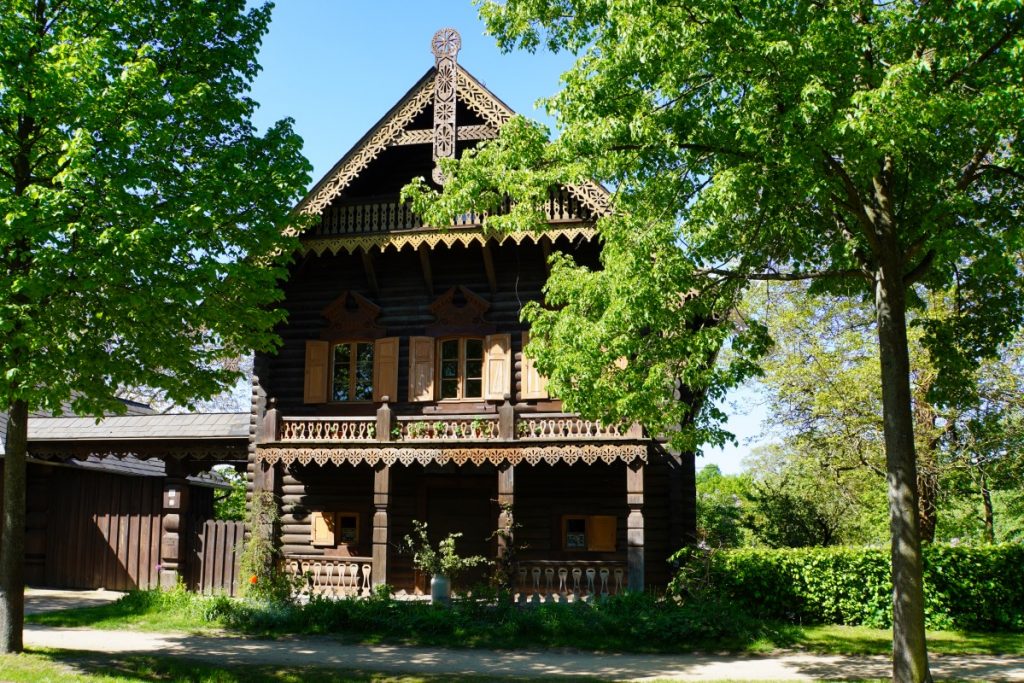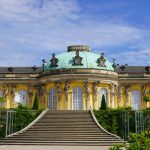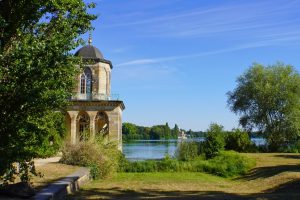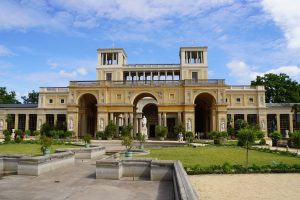When walking through Potsdam, you shouldn’t miss visiting the Russian Colony Alexandrowka. The beautiful wooden houses are truly unique and are even on the World Heritage List.
How did the Russian wooden houses come to Potsdam?
After the death of the Russian Tsar Alexander I, Friedrich Wilhelm III wished to bring a piece of Russia to Potsdam in his memory. So in 1826/27 the wooden houses were built in the Russian style. The park village of Glasovo near St. Petersburg served as a model. Lenné designed the grounds to go with it. He planned a system of avenues that formed a St. Andrew’s cross in the centre and was intended to pay homage to one of the most important saints of the Russian church, the Apostle Andrew.

The neighbouring Kapellenberg (at that time it was first called Minenberg and then Alexanderberg) was chosen as the site for the church. It was to be well visible above the residential houses.
The 13 wooden houses of the Russian colony Alexandrowka with their associated farmsteads were built by about 100 military craftsmen. Half-timbered houses with semi-circular logs were built, which externally gave the impression of Russian log houses. Following the Russian model, the roofs of the houses were to be covered with thatch, but a cheaper version made of wooden planking was chosen. At the end of the 19th century, this was replaced by slate roofing. Each of the 12 farmsteads consists of a residential house with a balcony and a loggia in front. A covered gateway connects the house with a small stable building. I find the beautiful design of the façade with the carvings particularly striking.

The 13th house is a two-storey warden’s house without a large garden. A 14th house was built next to the church. On the upper floor of this house was the royal samovar room and on the ground floor the flat of the church warden.
Hundreds of fruit varieties were planted in the gardens. These served as visual aids and also showed the agricultural policy of Friedrich Wilhelm III. Today, the fruit plantations have been expanded to about 600 historical varieties.

Who lives in the houses of the Russian Colony Alexandrowka?
In October 1812, 62 Russian soldiers taken prisoner came to Potsdam. At the king’s request, they formed the “Russian Singers’ Choir” and served in the first Prussian Guard Regiment. As a “gift” from the Tsar, the men remained at the royal court in Potsdam. After some of the singers died, the Tsar sent seven more singers to Potsdam. When the Tsar died in 1825, 12 Russian singers were still living in Potsdam.
These singers first moved into the fully furnished houses of the Russian Colony Alexandrowka, but only after they were married. Even the gardens were laid out and each household was given a cow.

The king also stipulated that the houses could not be sold, mortgaged or given away and could only be inherited in the direct male line.
So it came about quite quickly that many of the houses reverted to the king’s possession. He then subcontracted them to deserving sergeants.
The last singer died in 1861. 100 years after the first Russian singers moved in (1927), 4 houses were still inhabited by direct descendants. In 2013, three families still lived there: the 6th generation of the Grigorieff family, the 7th generation of the Anisimoff family and the 6th generation of the Jablokoff family.

In the 14th house on the Kapellenberg, the Royal Country House, which is somewhat off the beaten track, the king occasionally invited guests to tea. Today, the priest of the adjacent Alexander Nevsky Church lives here. He looks after about 1000 Orthodox believers of various nationalities.
Today, most of the houses are occupied by private individuals. House 2 houses a small museum about the Russian colony Alexandrowka. House 1 is now a restaurant where you can eat Russian food. Here you can get pelmeni, borscht and kvass, for example.

Alexander Nevsky Memorial Church
Via a well-signposted path, our tour takes us to the small hill next to the Russian colony Alexandrowka. Here stands the beautiful Alexander Nevsky Memorial Church, planned by Karl Friedrich von Schinkel.

Schinkel was in the Prussian service and was busy building Glienicke Palace and the Old Museum when he was commissioned to build the church. He used a church in Kiev, which had been built by a well-known Russian architect, as a model.

After the laying of the foundation stone in 1826, which took place in the presence of Friedrich Wilhelm III, a church was built within three years that combines both Russian and German architectural elements.
If you walk around the church, you will notice that the façade looks the same on all sides. Above the arches you can see patron saints, for example Theodorus Stratilates, the patron saint of soldiers, and Alexander Nevsky, the Grand Prince and national saint of Russia. I particularly like the brightly coloured design of the façades. It makes the building look cheerful and inviting.

In the small fenced churchyard are the church bells and some gravestones.
Address:
Russische Kolonie Alexandrowka
Alexandrowka 2
14469 Potsdam
Museum opening hours:
Thursday to Tuesday: 10 a.m. – 6 p.m.
Wednesday closed
Admission fees:
Adults € 3.50
Discounts are available.

















Leave a Reply